Last year we reported on how the Roman Space Telescope’s backers hoped it would be able to detect rogue planets using a technique called “microlensing”. Now, a team led by Iain McDonald, then at the University of Manchester, beat them to the punch by finding a few examples of Earth-sized rogue planets using data from an already aging space telescope – Kepler.
Continue reading “Multiple Earth-Mass Rogue Planets Have Been Discovered Drifting Through the Milky Way”Roman Space Telescope Will Also Find Rogue Black Holes
In the past we’ve reported about how the Roman Space Telescope is going to potentially be able to detect hundreds of thousands of exoplanets using a technique known as “microlensing”. Exoplanets won’t be the only things it can find with this technique though – it should be able to find solitary black holes as well.
Continue reading “Roman Space Telescope Will Also Find Rogue Black Holes”Roman Telescope Could Turn up Over 100,000 Planets Through Microlensing
Recently we reported on a haul of 2,200 new exoplanets from the 2 year primary mission of the Transiting Exoplanet Survey Satellite (TESS). But that is just the tip of the iceberg in terms of exoplanet hunting. If calculations from NASA are correct the Nancy Grace Roman Space Telescope could detect up to 100,000 new exoplanets when it launches in 2025.
Continue reading “Roman Telescope Could Turn up Over 100,000 Planets Through Microlensing”A Rogue Earth-Mass Planet Has Been Discovered Freely Floating in the Milky Way Without a Star

If a solar system is a family, then some planets leave home early. Whether they want to or not. Once they’ve left the gravitational embrace of their family, they’re pretty much destined to drift through interstellar space forever, unbound to any star.
Astronomers like to call these drifters “rogue planets,” and they’re getting better at finding them. A team of astronomers have found one of these drifting rogues that’s about the same mass as Mars or Earth.
Continue reading “A Rogue Earth-Mass Planet Has Been Discovered Freely Floating in the Milky Way Without a Star”WFIRST Will Use Relativity to Find More Exoplanets!
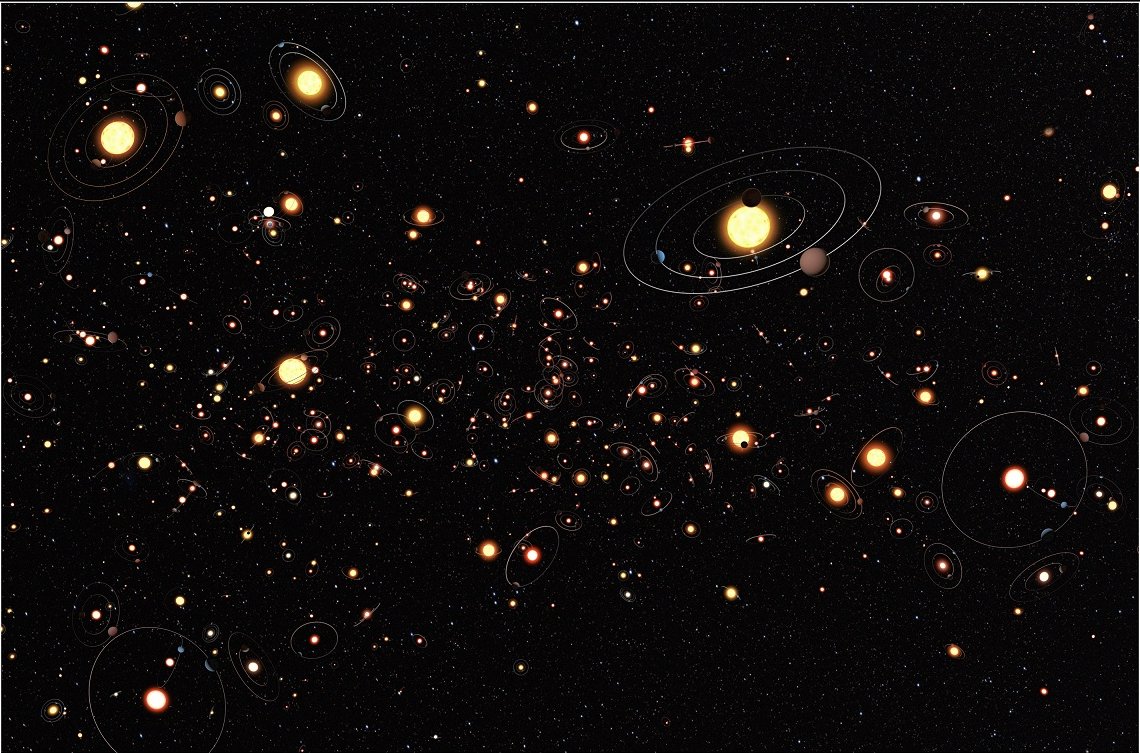
In 2025, NASA’s next-generation telescope, the Wide-Field Infrared Survey Telescope (WFIRST), will take to space and join in the search for extrasolar planets. Between its 2.4-meter (8 ft) telescope, 18 detectors, 300-megapixel camera, and the extraordinary survey speed it will offer, the WFIRST will be able to scan areas of the sky a hundred times greater than the Hubble Space Telescope.
Beyond its high-sensitivity and advanced suite of instruments, WFIRST will also rely on a technique known as Gravitational Microlensing to search for and characterize exoplanets. This is essentially a small-scale version of the gravitational lensing technique, where the gravitational force of a massive object between the observer and the target is used to focus and magnify the light coming from a distant source.
Continue reading “WFIRST Will Use Relativity to Find More Exoplanets!”The Most Distant Star Ever Seen, Only 4.4 Billion Years After the Big Bang
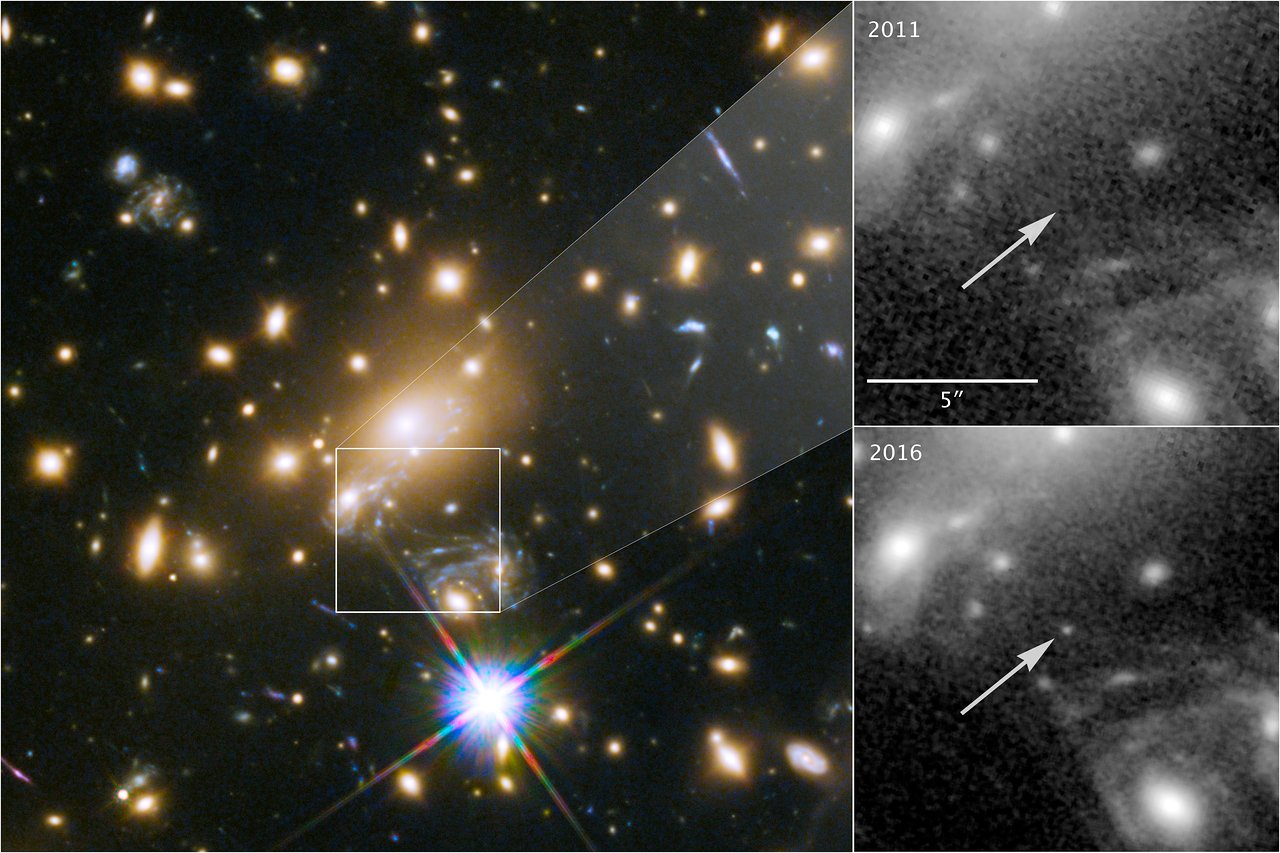
In 1990, the Hubble Space Telescope was placed into Low Earth Orbit. Since then, Hubble has gone on to become the most well-known space observatory and has revealed some never-before-seen things about our Universe. Despite the subsequent deployment of several flagship telescopes – like the Kepler Space Telescope, the Chandra X-ray Observatory and the Spitzer Space Telescope – Hubble is still accomplishing some amazing feats.
For instance, a team of astronomers recently used Hubble to locate the most distant star ever discovered. This hot blue star, which was located in a galaxy cluster, existed just 4.4 billion years after the Big Bang. The discovery of this star is expected to provide new insights into the formation and evolution of stars and galaxy clusters during the early Universe, as well as the nature of dark matter itself.
The discovery was made by an international team of scientists led by Patrick Kelly (of the University of Minnesota), Jose Diego (of the Instituto de Física de Cantabria in Spain) and Steven Rodney (of the University of South Carolina). Together, they observed the distant star in the galaxy cluster MACS J1149-2223 in April 2016 while studying the supernova explosion known as heic1525 (aka. Refsdal).
Using a technique known as gravitational microlensing, team relied on the total mass of the galaxy cluster itself to magnify the light coming from the supernova. However, while looking for this supernova, the team found an unexpected point source of light in the same galaxy. As Patrick Kelly explained in a recent Hubble press release:
“Like the Refsdal supernova explosion the light of this distant star got magnified, making it visible for Hubble. This star is at least 100 times farther away than the next individual star we can study, except for supernova explosions.”
The light observed from this star – named Lensed Star 1 (LS1) – was emitted just 4.4 billion years after the Big Bang (when the Universe was just 30% of its current age). The light was only detectable thanks to the microlensing effect caused by mass of the galaxy cluster and a compact object about three times the mass of our Sun within the galaxy itself. This allowed for the light coming from the star to be magnified by a factor of 2000.
Interestingly enough, the team also realized that this was not the first time this star had been observed. During a previous observation of the galaxy cluster, made in October 2016, the star was also acquired in an image – but went unnoticed at the time. As Diego noted:
“We were actually surprised to not have seen this second image in earlier observations, as also the galaxy the star is located in can be seen twice. We assume that the light from the second image has been deflected by another moving massive object for a long time — basically hiding the image from us. And only when the massive object moved out of the line of sight the second image of the star became visible.”
After finding the star in their survey, the team used Hubble again to obtain spectra from LS1 and determined that it is a B-type supergiant star – an extremely bright and blue class of star that has several times the mass of our Sun and is more than twice as hot. Given the star’s age, the discovery of LS1 is find on its own. At the same time, the discovery of this star will allow astronomers to gain new insights into the galaxy cluster itself.
As Steven Rodney indicated, “We know that the microlensing was caused by either a star, a neutron star, or a stellar-mass black hole.” As such, the discovery of LS1 will allow astronomers to study these objects (the latter of which are invisible) and estimate how many of them exist within this galaxy cluster.
Learning more about the constituents of galaxy clusters – the largest and most massive structures in the Universe – will also provide important clues about the composition of the Universe overall and how it evolved over time. This includes the important role played by dark matter in the evolution the Universe. As Kelly explained:
“If dark matter is at least partially made up of comparatively low-mass black holes, as it was recently proposed, we should be able to see this in the light curve of LS1. Our observations do not favour the possibility that a high fraction of dark matter is made of these primordial black holes with about 30 times the mass of the Sun.”
With the deployment of next-generation telescopes – like the James Webb Space Telescope – astronomers hope to learn even more about the earliest stars in the Universe. In so doing, they will be able to learn more about how it evolved over the past 10 billion years or so, and gain vital clues as to how dark matter played a role. In the meantime, Hubble still plays an all-important role in expanding our understanding of the cosmos.
And be sure to enjoy this episode of Hubblecast that explains this impressive find, courtesy of the ESA:
Further Reading: Hubble Space Telescope
For the First Time, Planets Have Been Discovered in ANOTHER Galaxy!

The first confirmed discovery of a planet beyond our Solar System (aka. an Extrasolar Planet) was a groundbreaking event. And while the initial discoveries were made using only ground-based observatories, and were therefore few and far between, the study of exoplanets has grown considerably with the deployment of space-based telescopes like the Kepler space telescope.
As of February 1st, 2018, 3,728 planets have been confirmed in 2,794 systems, with 622 systems having more than one planet. But now, thanks to a new study by a team of astrophysicists from the University of Oklahoma, the first planets beyond our galaxy have been discovered! Using a technique predicting by Einstein’s Theory of General Relativity, this team found evidence of planets in a galaxy roughly 3.8 billion light years away.
The study which details their discovery, titled “Probing Planets in Extragalactic Galaxies Using Quasar Microlensing“, recently appeared in The Astrophysical Journal Letters. The study was conducted by Xinyu Dai and Eduardo Guerras, a postdoctoral researcher and professor from the Homer L. Dodge Department of Physics and Astronomy at the University of Oklahoma, respectively.
For the sake of their study, the pair used the Gravitational Microlensing technique, which relies on the gravitational force of distant objects to bend and focus light coming from a star. As a planet passes in front of the star relative to the observer (i.e. makes a transit), the light dips measurably, which can then be used to determine the presence of a planet.
In this respect, Gravitational Microlensing is a scaled-down version of Gravitational Lensing, where an intervening object (like a galaxy cluster) is used to focus light coming from a galaxy or other large object located beyond it. It also incorporates a key element of the highly-effective Transit Method, where stars are monitored for dips in brightness to indicate the presence of an exoplanet.
In addition to this method, which is the only one capable of detecting extra-solar planets at truly great distances (on the order of billions of light years), the team also used data from NASA’s Chandra X-ray Observatory to study a distant quasar known as RX J1131–1231. Specifically, the team relied on the microlensing properties of the supermassive black hole (SMBH) located at the center of RX J1131–1231.
They also relied on the OU Supercomputing Center for Education and Research to calculate the microlensing models they employed. From this, they observed line energy shifts that could only be explained by the presence of of about 2000 unbound planets between the quasar’s stars – which ranged from being as massive as the Moon to Jupiter – per main-sequence star.
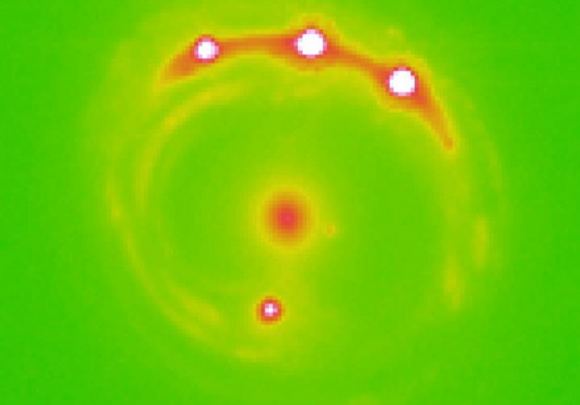
As Xinyu Dai explained in a recent University of Oklahoma press release:
“We are very excited about this discovery. This is the first time anyone has discovered planets outside our galaxy. These small planets are the best candidate for the signature we observed in this study using the microlensing technique. We analyzed the high frequency of the signature by modeling the data to determine the mass.”
While 53 planets have been discovered within the Milky Way galaxy using the Microlensing technique, this is the first time that planets have been observed in other galaxies. Much like the first confirmed discovery of an extra-solar planet, scientists were not even certain planets existed in other galaxies prior to this study. This discovery has therefore brought the study of planets beyond our Solar System to a whole new level!
And as Eduardo Guerras indicated, the discovery was possible thanks to improvements made in both modelling and instrumentation in recent years:
“This is an example of how powerful the techniques of analysis of extragalactic microlensing can be. This galaxy is located 3.8 billion light years away, and there is not the slightest chance of observing these planets directly, not even with the best telescope one can imagine in a science fiction scenario. However, we are able to study them, unveil their presence and even have an idea of their masses. This is very cool science.”
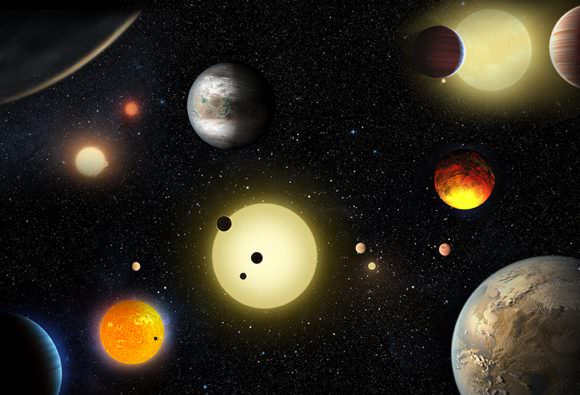
In the coming years, more sophisticated observatories will be available, which will allow for even more in the way of discoveries. These include space-based instruments like the James Webb Space Telescope (which is scheduled to launch in Spring of 2019) and ground-based observatories like the ESO’s OverWhelmingly Large (OWL) Telescope, the Very Large Telescope (VLT), the Extremely Large Telescope (ELT), and the Colossus Telescope.
At this juncture, the odds are good that some of these discoveries will be in neighboring galaxies. Perhaps then we can begin to determine just how common planets are in our Universe. At present, it is estimated that could be as many as 100 billion planets in the Milky Way Galaxy alone! But with an estimated 1 to 2 trillion galaxies in the Universe… well, you do the math!
Further Reading: University of Oklahoma, The Astrophysical Journal Letters
What is the Gravitational Microlensing Method?
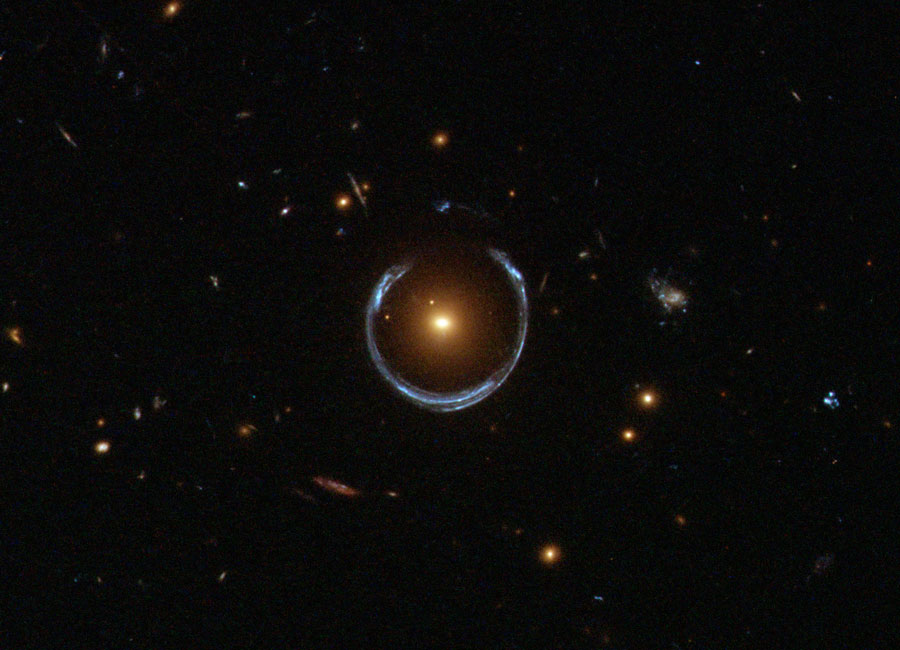
Welcome back to our series on Exoplanet-Hunting methods! Today, we look at the curious and unique method known as Gravitational Microlensing.
The hunt for extra-solar planets sure has heated up in the past decade. Thanks to improvements made in technology and methodology, the number of exoplanets that have been observed (as of December 1st, 2017) has reached 3,710 planets in 2,780 star systems, with 621 system boasting multiple planets. Unfortunately, due to various limits astronomers are forced to contend with, the vast majority have been discovered using indirect methods.
One of the more commonly-used methods for indirectly detecting exoplanets is known as Gravitational Microlensing. Essentially, this method relies on the gravitational force of distant objects to bend and focus light coming from a star. As a planet passes in front of the star relative to the observer (i.e. makes a transit), the light dips measurably, which can then be used to determine the presence of a planet.
In this respect, Gravitational Microlensing is a scaled-down version of Gravitational Lensing, where an intervening object (like a galaxy cluster) is used to focus light coming from a galaxy or other object located beyond it. It also incorporates a key element of the highly-effective Transit Method, where stars are monitored for dips in brightness to indicate the presence of an exoplanet.
Description:
In accordance with Einstein’s Theory of General Relativity, gravity causes the fabric of spacetime to bend. This effect can cause light affected by an object’s gravity to become distorted or bent. It can also act as a lens, causing light to become more focused and making distant objects (like stars) appear brighter to an observer. This effect occurs only when the two stars are almost exactly aligned relative to the observer (i.e. one positioned in front of the other).
These “lensing events” are brief, but plentiful, as Earth and stars in our galaxy are always moving relative to each other. In the past decade, over one thousand such events have been observed, and typically lasted for a few days or weeks at a time. In fact, this effect was used by Sir Arthur Eddington in 1919 to provide the first empirical evidence for General Relativity.
This took place during the solar eclipse of May 29th, 1919, where Eddington and a scientific expedition traveled to the island of Principe off the coast of West Africa to take pictures of the stars that were now visible in the region around the Sun. The pictures confirmed Einstein’s prediction by showing how light from these stars was shifted slightly in response to the Sun’s gravitational field.
The technique was originally proposed by astronomers Shude Mao and Bohdan Paczynski in 1991 as a means of looking for binary companions to stars. Their proposal was refined by Andy Gould and Abraham Loeb in 1992 as a method of detecting exoplanets. This method is most effective when looking for planets towards the center of the galaxy, as the galactic bulge provides a large number of background stars.
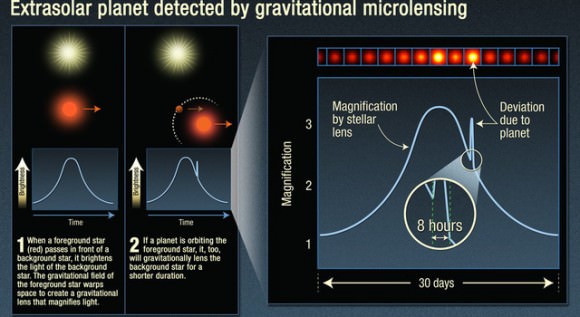
Advantages:
Microlensing is the only known method capable of discovering planets at truly great distances from the Earth and is capable of finding the smallest of exoplanets. Whereas the Radial Velocity Method is effective when looking for planets up to 100 light years from Earth and Transit Photometry can detect planets hundreds of light-years away, microlensing can find planets that are thousands of light-years away.
While most other methods have a detection bias towards smaller planets, the microlensing method is the most sensitive means of detecting planets that are around 1-10 astronomical units (AU) away from Sun-like stars. Microlensing is also the only proven means of detecting low-mass planets in wider orbits, where both the transit method and radial velocity are ineffective.
Taken together, these benefits make microlensing the most effective method for finding Earth-like planets around Sun-like stars. In addition, microlensing surveys can be effectively mounted using ground-based facilities. Like Transit Photometry, the Microlensing Method benefits from the fact that it can be used to survey tens of thousands of stars simultaneously.
Disadvantages:
Because microlensing events are unique and not subject to repeat, any planets detected using this method will not be observable again. In addition, those planets that are detected tend to be very far way, which makes follow-up investigations virtually impossible. Luckily, microlensing detections generally do not require follow-up surveys since they have a very high signal-to-noise ratio.
While confirmation is not necessary, some planetary microlensing events have been confirmed. The planetary signal for event OGLE-2005-BLG-169 was confirmed by HST and Keck observations (Bennett et al. 2015; Batista et al. 2015). In addition, microlensing surveys can only produce rough estimations of a planet’s distance, leaving significant margins for error.
Microlensing is also unable to yield accurate estimates of a planet’s orbital properties, since the only orbital characteristic that can be directly determined with this method is the planet’s current semi-major axis. As such, planet’s with an eccentric orbit will only be detectable for a tiny portion of its orbit (when it is far away from its star).
Finally, microlensing is dependent on rare and random events – the passage of one star precisely in front of another, as seen from Earth – which makes detections both rare and unpredictable.
Examples of Gravitational Microlensing Surveys:
Surveys that rely on the Microlensing Method include the Optical Gravitational Lensing Experiment (OGLE) at the University of Warsaw. Led by Andrzej Udalski, the director of the University’s Astronomical Observatory, this international project uses the 1.3 meter “Warsaw” telescope at Las Campanas, Chile, to search for microlensing events in a field of 100 stars around the galactic bulge.
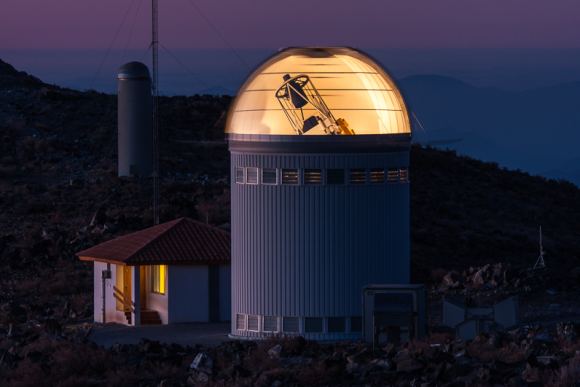
There is also the Microlensing Observations in Astrophysics (MOA) group, a collaborative effort between researchers in New Zealand and Japan. Led by Professor Yasushi Muraki of Nagoya University, this group uses the Microlensing Method to conduct surveys for dark matter, extra-solar planets, and stellar atmospheres from the southern hemisphere.
And then there’s the Probing Lensing Anomalies NETwork (PLANET), which consists of five 1-meter telescopes distributed around the southern hemisphere. In collaboration with RoboNet, this project is able to provide near-continuous observations for microlensing events caused by planets with masses as low as Earth’s.
The most sensitive survey to date is the Korean Microlensing Telescope Network (KMTNet), a project initiated by the Korea Astronomy and Space Science Institute (KASI) in 2009. KMTNet relies on the instruments at three southern observatories to provide 24-hour continuous monitoring of the Galactic bulge, searching for microlensing events that will point the way towards earth-mass planets orbiting with their stars habitable zones.
We have written many interesting articles on exoplanet detection here at Universe Today. Here is What are Extra Solar Planets?, What is the Transit Method?, What is the Radial Velocity Method?, What is Gravitational Lensing? and Kepler’s Universe: More Planets in our Galaxy than Stars
For more information, be sure to check out NASA’s page on Exoplanet Exploration, the Planetary Society’s page on Extrasolar Planets, and the NASA/Caltech Exoplanet Archive.
Astronomy Cast also has relevant episodes on the subject. Here’s Episode 208: The Spitzer Space Telescope, Episode 337: Photometry, Episode 364: The CoRoT Mission, and Episode 367: Spitzer Does Exoplanets.
Sources:



